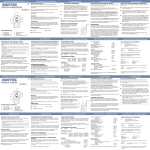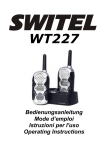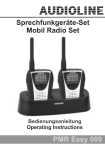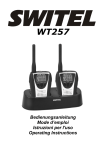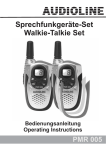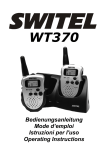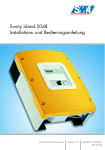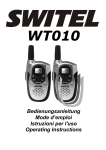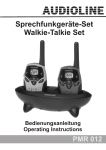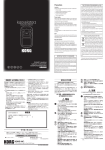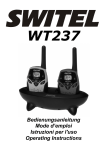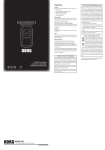Download WT117 - Switel
Transcript
WT117 Bedienungsanleitung Mode d’emploi Istruzioni per l'uso Operating Instructions WT117 Bedienungsanleitung __________ 1 Mode d’emploi ______________ 13 Istruzioni per l'uso __________ 23 Operating instructions ________ 33 Declaration of Conformity_____ 43 2 - Inhaltsverzeichnis 1 2 Bedienelemente ............................. 4 Inbetriebnahme ............................. 5 2.1 2.2 2.3 2.4 2.5 2.6 3 Bedienung ..................................... 7 3.1 3.2 3.3 3.4 3.5 3.6 3.7 3.8 4 Verpackungsinhalt prüfen ..................... 5 Akkupacks einsetzen ............................ 5 Gürtelclip anbringen............................. 6 Ladestation anschliessen ...................... 6 Funkgeräte laden................................. 6 Headset anschliessen ........................... 6 Einschalten der Funkgeräte ................... 7 Automatischer Energiesparmodus .......... 7 Kanalwahl........................................... 7 3.3.1 Ändern des Rufcodes ................. 8 Anruf bei einem anderen Teilnehmer...... 8 Kanalsperre ........................................ 9 Reichweite der Funkgeräte...................10 Erhöhung der maximalen Reichweite.....10 Displaybeleuchtung.............................10 Wichtige Informationen ..................11 4.1 4.2 Technische Daten ...............................11 Pflegeanleitung...................................12 3 - Bedienelemente 1 Bedienelemente 11 1 2 10 3 9 8 7 4 1. 2. 3. 4. 5. 6. 4 5 6 Mikro- Kopfhöreranschluss Ein/Aus-Taste Kanalschalter CHANNEL Taste MODE Kanalsperre Lautstärke lauter 7. 8. 9. 10. 11. 12. 12 Lautstärke leiser Displaybeleuchtung Taste CALL Taste TALK Headset Akkupack - Inbetriebnahme 2 2.1 Inbetriebnahme Verpackungsinhalt prüfen Zum Lieferumfang gehören: zwei Funkgeräte mit Gürtelclip zwei Akkupacks eine Bedienungsanleitung 2.2 eine Ladestation ein Steckernetzteil zwei Headsets Akkupacks einsetzen Ihr Funkgerät wurde mit zwei wiederaufladbaren Ni-MH Akkupacks geliefert, die vor der Inbetriebnahme eingebaut werden müssen. 1. 2. 3. Entriegeln Sie den Akkufachdeckel auf der Rückseite und öffnen Sie das Fach. Sollte der Gürtelclip befestigt sein, muss dieser zuerst entfernt werden. Legen Sie nun den Akkupack ein und achten Sie auf die richtige Polung. Falsche Polung kann sowohl das Akkupack als auch das Gerät beschädigen. Schliessen Sie das Akkufach. Hinweis: Wenn das Akkupack schwach ist und wieder geladen werden muss, blinkt im Display das Batteriesymbol Ladung erscheint die Anzeige . Bei voller . Hinweis: Keine anderen aufladbaren Batterien verwenden. Diese können möglicherweise einen Kurzschluss verursachen. Batterien nicht ins Feuer werfen oder ins Wasser tauchen. Alte oder defekte Batterien nicht mit dem normalen Hausmüll entsorgen. 5 - Inbetriebnahme 2.3 Gürtelclip anbringen Nachdem Sie die Akkupacks eingebaut haben, können Sie die mitgelieferten Gürtelclips befestigen. Schieben Sie den Gürtelclip von unten in die Führung bis er hörbar einrastet. Um den Gürtelclip wieder zu lösen, ziehen Sie die Befestigungslasche etwas nach oben und ziehen Sie den Gürtelclip nach unten. 2.4 Ladestation anschliessen Stecken Sie den Stecker des Netzteils in die Buchse an der Ladestation und das Steckernetzteil in eine vorschriftsmässig installierte Netzsteckdose mit 230V. Verwenden Sie aus Sicherheitsgründen nur das mitgelieferte Steckernetzteil. 2.5 Funkgeräte laden Die wiederaufladbaren Akkupacks der beiden Funkgeräte besitzen eine Standby-Zeit bei Zimmertemperatur von max. 30 Stunden und eine maximale Nutzungsdauer von bis zu 20 Stunden. Die aktuelle Batteriekapazität wird im Display angezeigt: Zum Laden stellen Sie die Funkgeräte für ca. 14 Stunden in die Ladestation. Voll 2.6 fast leer Keine Anzeige Batterien sind entladen. Headset anschliessen Die Funkgeräte können einem externen Mikrofon und Ohrhörer, ein sogenanntes Headset, betrieben werden. So bleiben Ihre Hände für andere Tätigkeiten frei. Die beiden Anschlüsse befinden Sie auf der Oberseite unter einer Abdeckung. Öffnen Sie die Abdeckung an der Oberseite des Funkgerätes und stecken Sie den Doppelstecker in die Anschlussbuchsen. Lautsprecher und Mikrofon im sind bei Headsetbetrieb abgeschaltet. An dem kleinen Mikrofon finden Sie die Taste zum Sprechen. Achten Sie darauf, dass die Mikrofonöffnung frei bleibt. Bei Verwendung des Headsets empfehlen wir die Tastatursperre am Funkgerät zu aktivieren, damit nichts unbeabsichtigt verstellt werden kann. 6 - Bedienung 3 Bedienung 3.1 Einschalten der Funkgeräte Um ein Funkgerät einzuschalten, halten Sie die Ein/Aus-Taste bis zu einem Signalton gedrückt. Für einige Sekunden wird das Display beleuchtet und alle Displaysymbole werden angezeigt. Danach zeigt das Display den aktuell eingestellten Kanal. 3.2 Automatischer Energiesparmodus Die Funkgeräte sind mit einem Stromsparmodus ausgestattet. Wenn innerhalb von 10 Sekunden keine Übertragungen vorkommen, schaltet das Gerät automatisch zum Batterieschonbetrieb um. Im Display blinkt die Anzeige STANDBY. Der Stromsparmodus wird automatisch beendet, sobald Sie irgendeine Taste drücken. Der automatische Stromsparmodus beeinträchtigt nicht den Empfang von eingehenden Übertragungen. 3.3 Kanalwahl Die Funkgeräte verfügen über 8 verschiedene Übertragungskanäle, die von dem europäischen Komitee für Funkkommunikation als „Private Mobile Radio“, kurz PMR genannt, freigegeben wurden. Um zwischen zwei Funkgräten zu sprechen, müssen beide Geräte auf den gleichen Kanal eingestellt sein. Wählen Sie zwischen den 8 Kanälen, indem Sie den Schalter CHANNEL auf der rechten Seite oben oder unten drücken. Das Display zeigt den jeweils eingestellten Kanal an. Sie können auch mit anderen Geräten in Verbindung treten, die ebenfalls über die PMR Kanäle verfügen, und auf die selbe Frequenz eingestellt sind. Bitte beachten Sie hierzu die Technischen Daten. 7 - Bedienung 3.3.1 Ändern des Rufcodes Normalerweise werden alle Gespräche auf dem gewählten Kanal an allen Funkgeräten signalisiert, die sich im Empfangsbereich befinden. Somit hören Sie eventuell auch Gespräche, die nicht für Sie bestimmt sind, wenn in der Nähe anderen Personen Funkgeräte auf dem selben Kanal verwenden. Um dies zu vermeiden, kann ein Rufcode festgelegt werden. Informieren Sie sich untereinander, welcher Code gewählt wurde. Drücken Sie einmal kurz die Taste MODE. Im Display blinkt der aktuelle Rufcode. Mit den Tasten CHANNEL + und – kann nun ein neuer Code zwischen 00 und 38 gewählt werden. Wird der Code 00 gewählt, werden alle Gespräche auf dem eingestellten Kanal geführt. Funkgerät 1 3 05 Funkgerät 2 3 05 Hinweis: Der ausgewählte Kanal und der Rufcode müssen übereinstimmen, damit Sie untereinander sprechen können. 3.4 Anruf bei einem anderen Teilnehmer Wenn Sie mit anderen Teilnehmern sprechen möchten, gehen Sie wie folgt vor: Die beiden Funkgeräte müssen eingeschaltet und auf den gleichen Kanal eingestellt sein. Drücken Sie einmal die kleine Taste CALL auf der linken Seite. An dem gerufenen Gerät erklingt ein Rufton von zwei Sekunden. Warten Sie nun bis der Gesprächspartner sich meldet. Um selbst zu sprechen drücken Sie die Taste TALK. Halten Sie das Gerät ca. 5 cm vom Mund entfernt und sprechen Sie in normaler Lautstärke. Lassen Sie danach die Taste TALK wieder los. Ihr Gesprächspartner hört einen Signalton, wenn Sie die Taste TALK loslassen. Damit wird dem anderen Teilnehmer angezeigt, dass Sie mit dem Sprechen fertig sind und auf eine Antwort warten. 8 - Bedienung Die Lautstärke des ankommenden Anrufsignals hängt von Ihrer Lautstärkeeinstellung ab. Mit den Tasten VOL- und VOL+ können acht Lautstärkestufen eingestellt werden. Für 5 Sekunden wird die gewählte Lautstärke im Display angezeigt. Danach springt das Display wieder zur Kanaleinstellung. Hinweis: Während Sie die Taste TALK festhalten, können Sie keine ankommenden Anrufe hören. Von beiden Gesprächspartnern kann, wie bei Funkgeräten üblich, nur ein Gesprächspartner sprechen. Warten Sie also immer, bis Sie den Signalton hören, bevor Sie wieder die Taste TALK drücken. Während Sie die Taste TALK drücken, erscheint im Display das Symbol . Wenn Sie ein Gespräch empfangen, erscheint im Display das Symbol 3.5 . Kanalsperre Um zu verhindern, das der eingestellte Kanal unbeabsichtigt verstellt wird, können Sie die Kanalsperre einschalten. Halten Sie dazu die Taste für eine Sekunde gedrückt. Im Display und die Kanalwahl ist gesperrt. Die anderen blinkt das Symbol Tasten wie TALK, CALL und die Lautstärketaster sind nicht gesperrt. Um die Tastatursperre wieder aufzuheben, halten Sie die Taste wieder für eine Sekunde fest. Das Symbol verschwindet und die Kanalsperre ist aufgehoben. Hinweis: Nach jedem neuen Einschalten ist die Kanalsperre automatisch wieder ausgeschaltet. 9 - Bedienung 3.6 Reichweite der Funkgeräte Die Funkgeräte haben eine Reichweite von bis zu 3 km. Diese maximale Reichweite kann durch bestimmte Umstände verringert werden. Bei flachen, offenen Bedingungen erreichen Sie die maximale Reichweite. Befinden sich Gebäude oder Bäume im Signalweg wird die Reichweite verringert. Die Reichweite wird in hügeligem Gelände noch weiter verringert. 3.7 Erhöhung der maximalen Reichweite Die Funkgeräte sind mit einem sogenannten AUTO-SQUELCH ausgestattet, mit dem automatisch schwache Übertragungen und unerwünschte Geräusche während der Benutzung ausgeblendet werden. Dieser AUTO-SQUELCH kann vorübergehend ausgeschaltet werden, um die Reichweite zu erhöhen. Halten Sie die Taste für mehr als fünf Sekunden bis zu einem Signalton gedrückt. Die automatische Unterdrückung ist abgeschaltet, und es können nun auch sehr schwache Signale empfangen werden. Um das AUTO-SQUELCH wieder einzuschalten, drücken Sie entweder erneut die Taste halbe Sekunde. oder eine Taste der Kanalwahl für eine Hinweis: Sie können das AUTO-SQUELCH auch temporär abschalten. Halten Sie dazu die Taste gedrückt. Das AUTO- SQUELCH bleibt nun solange abgeschaltet, bis Sie die Taste wieder loslassen. 3.8 Displaybeleuchtung Das Display der Funkgeräte lässt sich für 10 Sekunden beleuchten, drücken. Auch durch das Drücken der indem Sie die Taste Tasten CALL, TALK, VOLUME, MODE oder LOCK wird das Display jeweils für 10 Sekunden beleuchtet. Um das Licht vorher wieder abzuschalten, drücken Sie die Taste 10 . - Wichtige Informationen 4 4.1 Wichtige Informationen Technische Daten PMR Kanal Frequenzen (MHz) : Kanal 1: 446,00625 Kanal 2: 446,01875 Kanal 3: 446,03125 Kanal 4: 446,04375 Kanal 5: 446,05625 Kanal 6: 446,06875 Kanal 7: 446,08125 Kanal 8: 446,09375 38 CTCSS Ruffreqeuenzen: CH1=67.0Hz CH2=71.9Hz CH3=74.4Hz CH4=77.0Hz CH5=79.7Hz CH6=82.5Hz CH7=85.4Hz CH8=88.5Hz CH9=91.5Hz CH10=94.8Hz CH11= 97.4Hz CH12=100.0Hz CH13=103.5Hz CH14=107.2Hz CH15=110.9Hz CH16=114.8Hz CH17=118.8Hz CH18=123.0Hz CH19=127.3Hz CH20=131.8Hz CH21= 136.5Hz CH22=141.3Hz CH23=146.2Hz CH24=151.4Hz CH25=156.7Hz CH26=162.2Hz CH27=167.9Hz CH28=173.8Hz CH29=179.9Hz CH30=186.2Hz CH31= 192.8Hz CH32=203.5Hz CH33=210.7Hz CH34=218.1Hz CH35=225.7Hz CH36=233.6Hz CH37=241.8Hz CH38=250.3Hz Empfänger: Empfindlichkeit für 12 Sind: -119 dem für Anrufsignalerkennung: -121 dem Max. Rauschabstand bei 47 dem RF Eingang40 dB Max. Audioausgang bei 10% Klirrfaktor >150 mW Squelch Empfindlichkeit -121 dBm Ansprechzeit 150 ms Schliesszeit 250 ms Tonfrequenzverhalten bei 400 Hz -6 dB bei 2500 Hz -12 dB Signaldistanz Bandbreite +/- 5 kHz Kanaltrennung 12.5 kHz Intermodulationsunterdrückung 60 dB Störunterdrückung 60 dB 11 - Wichtige Informationen Sender: Effektive Ausgangsleistung Trägerfrequenzbeständigkeit Modulationsbegrenzung Ansprechzeit Träger Tonfrequenzverhalten bei 300 Hz bei 2,5 kHz Tonverzerrung Brummen und Rauschen Vorübergehendes Frequenzverhalten Sender ein Sender aus Stromversorgung: Gemischter Betrieb Standby Ladezeit für eine volle Aufladung Batteriespannung 500 mW 500 Hz 2,5 kHz 30 ms -10 dB 2 dB 2% 35 dB 30 ms <10 ms ca. 20 Stunden 30 Stunden 14 bis 16 Stunden 6.0 V Die technischen Daten können ohne vorherige Ankündigung geändert werden. 4.2 Pflegeanleitung Die Gehäuseoberfläche kann mit einem trockenen, weichen und fusselfreien Tuch gereinigt werden. Niemals Reinigungsmittel oder gar aggressive Lösungsmittel verwenden. Legen Sie das Gerät niemals an einen feuchten oder staubigen Platz. Vermeiden Sie die Nähe zu Wärmequellen wie Heizkörpern und setzen Sie das Gerät keiner direkten Sonnenbestrahlung aus. 12 - Sommaire 1 2 Eléments de commande .................14 Mise en service .............................15 2.1 2.2 2.3 2.4 2.5 2.6 3 Utilisation .....................................17 3.1 3.2 3.3 3.4 3.5 3.6 3.7 3.8 4 Vérifier le contenu de l’emballage .........15 Mettre les blocs de batterie en place .....15 Fixer le clip-ceinture ...........................16 Raccorder le chargeur .........................16 Charger les émetteurs-récepteurs.........16 Raccorder le micro-casque ...................16 Mise en marche des émetteurs-récepteurs..........................17 Mode automatique d’économie d’énergie ..........................17 Sélection de canal...............................17 3.3.1 Modifier le code d’appel..............18 Appeler un autre utilisateur..................18 Verrouillage de canal...........................19 Portée des émetteurs-récepteurs ..........20 Augmentation de la portée maximale ....20 Éclairage de l’écran.............................20 Informations importantes ...............21 4.1 4.2 Caractéristiques techniques .................21 Instructions d’entretien .......................22 13 - Eléments de commande 1 Eléments de commande 11 1 2 10 3 9 8 7 4 1. 2. 3. 4. 5. 6. 14 12 5 6 Raccordement micro-casque Touche marche/arrêt Interrupteur de canal CHANNEL Touche MODE Verrouillage de canal Volume plus fort 7. 8. 9. 10. 11. 12. Volume plus faible Éclairage de l’écran Touche CALL Touche TALK Micro-casque Blocs de batterie - Mise en service 2 Mise en service 2.1 Vérifier le contenu de l’emballage Le contenu de l’emballage : Deux émetteurs-récepteurs avec clip-ceinture Deux blocs de batterie Un mode d’emploi 2.2 Un chargeur Un bloc d’alimentation Deux micro-casques Mettre les blocs de batterie en place Votre émetteur-récepteur est fourni avec deux blocs de batterie NI-MH rechargeables que vous devez mettre en place avant la mise en service. 1. 2. 3. Déverrouillez le couvercle du compartiment de batterie au dos et ouvrez le compartiment. Vous devez d’abord enlever le clip-ceinture s’il est déjà fixé. Mettez ensuite le bloc de batterie en place en respectant la polarité adéquate. Une polarité inadéquate peut détériorer aussi bien le bloc de batterie que l’appareil. Fermez le compartiment de batterie. Remarque : lorsque le bloc de batterie est faible et doit être rechargé, le symbole de batterie clignote à l’écran. L’icône lorsque la batterie est pleine. s’affiche Remarque : ne pas utiliser d’autres batteries rechargeables qui risqueraient éventuellement de provoquer un court-circuit. Ne pas jeter les piles au feu, ni les plonger dans l’eau. Ne pas jeter les piles usées ou défectueuses en même temps que les ordures ménagères. 15 - Mise en service 2.3 Fixer le clip-ceinture Après avoir mis en place le bloc de batterie, vous pouvez fixer le clipceinture fourni. Enfoncez le clip-ceinture par le bas dans la coulisse jusqu'à ce qu'il s'enclenche de manière perceptible. Pour détacher à nouveau le clip-ceinture, tirez légèrement la languette de fixation vers le haut, puis tirez le clip-ceinture vers le bas. 2.4 Raccorder le chargeur Enfoncez la fiche du bloc d'alimentation dans la prise située sur le chargeur et le bloc d’alimentation dans une prise de courant de 230 V installée conformément aux dispositions réglementaires. Pour des raisons de sécurité, utilisez uniquement le bloc d’alimentation fourni. 2.5 Charger les émetteurs-récepteurs Les blocs de batterie rechargeables des deux émetteurs-récepteurs sont dotés à température ambiante d’une autonomie en veille de max. 30 heures et d’une durée maximale d’utilisation de 20 heures. La capacité de batterie actuelle est affichée à l’écran : Pour procéder au chargement, laissez les émetteurs-récepteurs en place dans le chargeur durant env. 14 heures. Presque vide Pleine 2.6 Pas d’icône Les batteries sont déchargées. Raccorder le micro-casque Les émetteurs-récepteurs peuvent être utilisés avec un micro externe et un écouteur, c’est-à-dire un « micro-casque ». Vous gardez ainsi les mains libres pour d’autres activités. Les deux raccordements se trouvent sur la face supérieure sous un cache. Ouvrez le cache de la face supérieure de l’émetteur-récepteur et enfoncez la double fiche dans les prises de raccordement. Le hautparleur et le micro sont désactivés lorsqu’un micro-casque est utilisé. La touche permettant de parler se trouve sur le petit micro. Veillez à ce que l’orifice du micro ne soit pas obstrué. Lors de l’utilisation d’un micro-casque, nous recommandons d’activer le verrouillage du clavier sur l’émetteur-récepteur pour éviter tout déréglage involontaire. 16 - Utilisation 3 3.1 Utilisation Mise en marche des émetteursrécepteurs Pour mettre en marche un émetteur-récepteur, maintenez la touche marche/arrêt enfoncée jusqu’au retentissement d’un signal sonore. L’écran s’éclaire pendant quelques secondes et toutes les icônes d’écran s’affichent. L’écran affiche ensuite le canal actuellement réglé. 3.2 Mode automatique d’économie d’énergie Les émetteurs-récepteurs sont équipés d’un mode d’économie de courant. En l’absence de transmission durant 10 secondes, l’appareil se met automatiquement en mode d’économie de batterie. Le message STANDBY clignote à l’écran. Le mode d’économie de courant est automatiquement interrompu dès que vous appuyez sur une touche quelconque. Le mode automatique d’économie de courant ne gêne pas la réception de transmissions entrantes. 3.3 Sélection de canal Les émetteurs-récepteurs disposent de 8 canaux de transmission autorisés par le comité européen de radiocommunication en tant que « private mobile radio » (radio portative privée), en abrégé PMR. Pour permettre l’établissement d’une communication entre deux appareils, ceux doivent être réglés sur le même canal. Sélectionnez l’un des 8 canaux en amenant vers le haut ou le bas le commutateur CHANNEL situé sur le côté droit. L’écran affiche le canal réglé. Vous pouvez aussi établir une liaison avec d’autres appareils dotés également de canaux PMR et réglés sur la même fréquence. Veuillez respecter à cet effet les caractéristiques techniques. 17 - Utilisation 3.3.1 Modifier le code d’appel Normalement, tous les signaux d’appel sont signalés sur le canal sélectionné sur tous les émetteurs-récepteurs se trouvant dans la zone de réception. Vous pouvez ainsi éventuellement entendre également des signaux d’appareil qui ne vous sont pas destinés lorsque d’autres utilisateurs d’émetteurs-récepteurs se trouvant à proximité utilisent le même canal. Un code d’appel peut être déterminé afin d’éviter cela. Mettez-vous d’accord avec vos interlocuteurs sur un code afin que les signaux d’appel de l’interlocuteur soit signalisé sur chaque émetteur-récepteur. Appuyez une fois brièvement sur la touche MODE. Le code d’appel actuel clignote à l’écran. Les touches CHANNEL + et – permettent alors de sélectionner un nouveau code de 00 à 38. Si le code 00 est sélectionné, toutes les tentatives d’appel sont signalées sur le canal réglé. Emetteurs-récepteurs 1 3 05 Emetteurs-récepteurs 2 3 05 Remarque : le canal sélectionné et le code d’appel doivent concorder afin que vous puissiez communiquer entre vous. 3.4 Appeler un autre utilisateur Procédez de la manière suivante si vous souhaitez converser avec d’autres utilisateurs : Les deux émetteurs-récepteurs doivent être mis en marche et réglés sur le même canal. Appuyez une fois sur la petite touche CALL située sur le côté gauche. Une sonnerie retentit pendant deux secondes sur l’appareil appelé. Attendez alors que votre interlocuteur réponde. Pour parler vous-même, appuyez sur la touche TALK. Maintenez l’appareil à environ 5 cm de votre bouche et parlez d’une voix normalement forte. Relâchez ensuite la touche TALK. Votre interlocuteur entend un signal sonore lorsque vous relâchez la touche TALK. Cela indique à l’autre utilisateur que vous avez fini de parler et que vous attendez une réponse. 18 - Utilisation Le volume du signal d’appel que vous recevez dépend du volume que vous avez réglé. Les touches VOL- et VOL+ vous permettent de régler le volume sur huit niveaux différents. Le volume sélectionné est affiché à l’écran durant 5 secondes. L’écran affiche ensuite de nouveau le réglage de canal. Remarque : vous ne pouvez pas entendre les appels que vous recevez lorsque vous maintenez la touche TALK enfoncée. Un seul interlocuteur à la fois peut parler, comme c’est habituellement le cas pour les émetteurs-récepteurs. Attendez donc toujours le signal sonore avant d’appuyer à nouveau sur la touche TALK. Pendant vous appuyez sur la touche TALK, l’icône s’affiche à l’écran. Lorsque vous recevez une communication, l’écran affiche l’icône 3.5 . Verrouillage de canal Vous pouvez activer le verrouillage de canal pour empêcher le déréglage involontaire du canal réglé. Maintenez à cet effet la touche enfoncée durant une seconde. clignote à l’écran et la sélection de canal est verrouillée. L’icône Les autres touches telles que TALK, CALL et la touche de volume ne sont pas verrouillées. Pour supprimer le verrouillage du clavier, maintenez la touche nouveau enfoncée durant une seconde. L’icône disparaît et le verrouillage de canal est supprimé. à Remarque : le verrouillage de canal est automatiquement désactivé après chaque nouvelle mise en marche. 19 - Utilisation 3.6 Portée des émetteurs-récepteurs Les émetteurs-récepteurs ont une portée pouvant atteindre 3 km. Cette portée maximale peut être réduite dans certaines conditions. Vous obtenez une portée maximale sur un terrain plat et dans un espace ouvert. La portée est réduite si la trajectoire des signaux est entravée par des bâtiments ou des arbres. La portée est encore plus réduite sur un terrain accidenté. 3.7 Augmentation de la portée maximale Les émetteurs-récepteurs sont équipés d’un système « AUTOSQUELCH » permettant la suppression automatique des transmissions faibles et des bruits indésirables survenant durant l’utilisation. Vous pouvez désactiver provisoirement cette fonction AUTO SQUELCH afin d’augmenter la portée. Maintenez la touche enfoncée pendant plus de cinq secondes jusqu’au retentissement d’un signal sonore. La suppression automatique est désactivée et vous pouvez à présent recevoir même de très faibles signaux. Pour réactiver la fonction AUTO SQUELCH, appuyez de nouveau sur la touche ou sur une touche de sélection du canal durant une demi-seconde. Remarque : vous pouvez également désactiver temporairement la fonction AUTO-SQUELCH. Maintenez à cet effet la touche enfoncée. La fonction AUTO-SQUELCH reste désactivée jusqu’à ce que vous relâchiez la touche 3.8 . Éclairage de l’écran Vous pouvez éclairer l’écran des émetteurs-récepteurs durant 10 . L’écran s’allume également secondes en appuyant sur la touche à chaque fois durant 10 secondes lorsque vous appuyez sur les touches CALL, TALK, VOLUME, MODE ou LOCK. Appuyez sur la touche 20 pour éteindre avant l’éclairage. - Informations importantes 4 4.1 Informations importantes Caractéristiques techniques Fréquences des canaux PMR (MHz) : Canal 1 : 446,00625 Canal 2 : 446,01875 Canal 3 : 446,03125 Canal 4 : 446,04375 Canal 5 : 446,05625 Canal 6 : 446,06875 Canal 7 : 446,08125 Canal 8 : 446,09375 38 fréquences sonores CTCSS : CH1=67.0Hz CH2=71.9Hz CH3=74.4Hz CH4=77.0Hz CH5=79.7Hz CH6=82.5Hz CH7=85.4Hz CH8=88.5Hz CH9=91.5Hz CH10=94.8Hz CH11= 97.4Hz CH12=100.0Hz CH13=103.5Hz CH14=107.2Hz CH15=110.9Hz CH16=114.8Hz CH17=118.8Hz CH18=123.0Hz CH19=127.3Hz CH20=131.8Hz CH21= 136.5Hz CH22=141.3Hz CH23=146.2Hz CH24=151.4Hz CH25=156.7Hz CH26=162.2Hz CH27=167.9Hz CH28=173.8Hz CH29=179.9Hz CH30=186.2Hz CH31= 192.8Hz CH32=203.5Hz CH33=210.7Hz CH34=218.1Hz CH35=225.7Hz CH36=233.6Hz CH37=241.8Hz CH38=250.3Hz Récepteur : Sensibilité pour 12 sinad : pour détection de signaux d’appel : Rapport signal / bruit max. à 47 dBm radiofréquence entrée Sortie audio max. à 10% de facteur de distorsion Squelch Sensibilité Temps de réponse Temps de fermeture -121 dBm 150 ms 250 ms Comportement de fréquence vocale à 400 Hz à 2500 Hz Distance de signal largeur de bande Séparation des canaux Suppression de l’intermodulation Suppression des parasites -6 dB -12 dB +/- 5 kHz 12.5 kHz 60 dB 60 dB -119 dBm -121 dBm 40 dB >150 mW 21 - Informations importantes Émetteur: Puissance de sortie effective Stabilité de la fréquence porteuse Limitation de modulation Durée de réponse porteuse Comportement de fréquence vocale à 300 Hz à 2,5 kHz Distorsion du son Ronflement et souffle Réponse en fréquence passagère Émetteur marche Émetteur arrêt Alimentation électrique : Usage mixte Autonomie en veille Temps pour charger entièrement les blocs de batterie Courant de batterie total 500 mW +/- 1 kHz 2,5 kHz 30 ms -10 dB 2 dB 2% 35 dB 30 ms <10 ms env. 20 heures 30 heures 14 à 16 heures 6,0 V Les caractéristiques techniques peuvent être modifiées sans avis préalable. 4.2 Instructions d’entretien Vous pouvez utiliser un chiffon sec, doux et non-pelucheux pour nettoyer les surfaces du boîtier. N'utilisez jamais de produits nettoyants ou de solvants agressifs. Ne placez jamais l’appareil dans un endroit humide ou poussiéreux. Évitez de placer l’appareil à proximité de sources de chaleur tels que les radiateurs et évitez une exposition directe au soleil. 22 - Sommario 1 2 3 Elementi di comando.................................... 24 Messa in funzione ........................................ 25 2.1 2.2 2.3 2.4 2.5 2.6 Impiego ..................................................... 27 3.1 3.2 3.3 3.4 3.5 3.6 3.7 3.8 4 Controllo del contenuto della confezione ........... 25 Inserimento degli accumulatori ....................... 25 Applicazione del clip della cintura..................... 26 Collegamento della stazione di carica ............... 26 Caricamento delle ricetrasmittenti ................... 26 Collegamento per auricolare ........................... 26 Inserimento delle ricetrasmittenti .................... 27 Modo di risparmio energetico automatico.......... 27 Selezione del canale....................................... 27 3.3.1 Modifica del codice di chiamata ............. 28 Chiamata in un altro utente ............................ 28 Blocco canale ................................................ 29 Portata delle ricetrasmittenti ........................... 30 Aumento della massima portata ...................... 30 illuminazione del display ................................. 30 Informazioni importanti ................................ 31 4.1 4.2 Dati tecnici ................................................... 31 Istruzioni per la manutenzione ........................ 32 23 - Elementi di comando 1 Elementi di comando 11 1 2 10 3 9 8 7 4 1. 2. 3. 4. 5. 6. 24 12 5 6 micro-collegamento cuffia interruttore ON/OFF selettore canale CHANNEL tasto MODE Blocco canale aumento volume 7. 8. 9. 10. 11. 12. riduzione volume illuminazione del display tasto CALL tasto TALK auricolare accumulatori - Messa in funzione 2 Messa in funzione 2.1 Controllo del contenuto della confezione La dotazione comprende: due ricetrasmittenti con clip a cintura due accumulatori istruzioni per l'uso 2.2 una stazione di carica un alimentatore di rete due auricolari Inserimento degli accumulatori La Vostra ricetrasmittente è stata fornita con due accumulatori al NiMH ricaricabili, che devono essere introdotti prima della messa in funzione. 1. 2. 3. Sbloccare il coperchio dell'alloggiamento degli accumulatori situato nella parte posteriore ed aprilo. Se vi fosse fissato il clip alla cintura, sarà dapprima necessario rimuoverlo. Introdurre a questo punto gli accumulatori e rispettare la corretta polarità. Un'inversione della polarità può direttamente danneggiare sia gli accumulatori che l'apparecchio stesso. Chiudere infine l'alloggiamento degli accumulatori. Avvertenza: se la capacità degli accumulatori dovesse essere troppo debole, con la necessità di una loro ricarica, nel display lampeggia il simbolo delle batterie . In stato di carica completa viene visualizzata l'indicazione . Avvertenza: non utilizzare mai delle altre batterie ricaricabili. Questi potrebbero causare eventualmente un corto circuito. Non gettare mai le batterie nel fuoco o immergerle nell'acqua. Le batterie vecchie o difettose non devono mai essere smaltite nei normali rifiuti urbani. 25 - Messa in funzione 2.3 Applicazione del clip della cintura Dopo aver integrato gli accumulatori, potete fissare il clip della cintura fornito in dotazione. Spingere il clip della cintura dal basso nella guida, fino a farlo scattare in posizione . Per staccare nuovamente il clip, basta tirare la linguetta di fissaggio leggermente verso l'alto e staccare poi il clip verso il basso. 2.4 Collegamento della stazione di carica Inserire la spina dell'alimentatore di rete nella boccola situata nella stazione di carica e l'alimentatore di rete in una presa di corrente da 230V installata conformemente alle prescrizioni vigenti sul luogo. Per motivi di sicurezza è necessario utilizzare esclusivamente l'alimentatore di rete fornito. 2.5 Caricamento delle ricetrasmittenti Gli accumulatori ricaricabili di ambedue le ricetrasmittenti sono previste per funzionare con un periodo standby a temperatura ambiente di max. 30 ore ed una durata di conversazione massima di 20 ore. La capacità attuale delle batterie viene indicata nel display. Per il procedimento di carica occorre appoggiare le ricetrasmittenti per la durata di ca. 14 ore nella stazione di carica. carica 2.6 quasi esaurita nessuna indicazione le batterie sono esaurite. Collegamento per auricolare Le ricetrasmittenti possono essere impiegate con un microfono esterno ed una cuffia, un cosiddetto sistema auricolare. Ciò permette per esempio di avere sempre le mani libere per delle altre attività. Le due prese di collegamento si trovano nella parte superiore sotto un coperchio. Aprire il coperchio nella parte superiore della rice-trasmittente e inserire la spina doppia nelle boccole di collegamento. Durante il funzionamento in auricolare l'altoparlante ed il microfono rimangono disattivati. Nel microfono piccolo si trova anche il tasto per parlare. Accertatevi però che l'apertura del microfono rimanga sempre libera. Nell'impiego dell'auricolare si raccomanda di attivare il blocco della tastiera nella ricetrasmittente, per prevenire delle variazioni involontarie delle regolazioni. 26 - Impiego 3 3.1 Impiego Inserimento delle ricetrasmittenti Per inserire una ricetrasmittente, mantenere premuto il tasto ON/OFF, fino a sentire un segnale acustico. Per alcuni secondi si illumina il display con la visualizzazione di tutti i simboli d'indicazione. Dopodiché nel display viene visualizzato il canale attualmente selezionato. 3.2 Modo di risparmio energetico automatico Le ricetrasmittenti sono equipaggiate di un sistema di risparmio energetico automatico. Se entro la durata di 10 secondi non avviene più alcuna radiotrasmissione, l'apparecchio di commuterà automaticamente al servizio di risparmio batterie. Dopodiché nel display lampeggia l'indicazione STANDBY. Il servizio di risparmio corrente viene automaticamente terminato, non appena viene premuto uno dei tasti dell'apparecchio. Il servizio automatico di risparmio corrente non pregiudica in alcun modo la ricezione dei segnali radio. 3.3 Selezione del canale Le ricetrasmittenti dispongono di 8 diversi canali di radiotrasmissione, omologati dal Comitato Europeo per radiocomunicazioni per l'impiego come „radio mobile privata“, detto in breve RMP. Per parlare attraverso due radiotrasmettitori, è necessario che ambedue le unità siano regolate sullo stesso canale. Selezionare uno degli 8 canali desiderati, premendo il commutatore CHANNEL situato in alto o in basso nella parte destra dell'apparecchio. Nel display viene visualizzato il canale attualmente regolato. Potete anche metterVi in comunicazione con delle altre unità, che dispongono altrettanto dei canali RMP e che sono regolati alla medesima frequenza. A tal fine si prega di osservare i dati tecnici. 27 - Impiego 3.3.1 Modifica del codice di chiamata Normalmente tutti i segnali di chiamata in tutte le ricetrasmittenti vengono segnalati sul canale selezionato, e che si trovano attualmente sul campo di ricezione. In questo modo potete sentire anche eventuali di chiamata non per voi stabiliti, quando in prossimità altre persone stanno utilizzando le ricetrasmittenti sullo stesso canale. Per evitare questo inconveniente, si può fissare un codice di chiamata. Sarebbe opportuno informarsi ossia concordarsi reciprocamente per stabilire quale codice è stato selezionato, affinché i segnali di chiamata dell'interlocutore vengano anche segnalati in ogni rispettiva ricetrasmittente. Premere brevemente una volta il tasto MODE. Nel display lampeggia ora l'attuale codice di chiamata. Tramite i tasti CHANNEL + e – potete ora selezionare un nuovo codice tra 00 e 38. Nella selezione del codice 00, verranno segnalati tutti i tentativi di chiamata sul canale selezionato. Ricetrasmittenti 1 3 05 Ricetrasmittenti 2 3 05 Avvertenza: il canale e il codice di chiamata selezionati devono coincidere, per poter stabilire la comunicazione reciproca. 3.4 Chiamata in un altro utente Se desiderate parlare con degli altri utenti, occorre procedere nel modo seguente: Ambedue le ricetrasmittenti devono essere inserite nonché regolate sullo stesso canale. Premere una volta il tasto piccolo CALL situato nella parte sinistra. Per la durata di due secondi nell'unità chiamata si sente un rispettivo segnale acustico. Attendere ora fino a quando non risponde l'interlocutore. Per poter parlare occorre premere il tasto TALK. Mantenere una distanza di ca. 5 cm dall'apparecchio e parlare a voce normale. Dopodiché rilasciare il tasto TALK. L'interlocutore a questo punto 28 - Impiego sente un segnale acustico, non appena rilasciate il tasto TALK. In tal modo al Vostro interlocutore viene segnalato il termine della Vostra frase e che siete in attesa di una risposta. Il volume del segnale di chiamata dipende sostanzialmente dalla regolazione del Vostro volume. tramite i tasti VOL- e VOL+ si possono regolare otto stadi di volume. Per la durata di 5 secondi nel display viene indicato il volume attualmente regolato. Dopodiché il display si ricommuta di nuovo alla regolazione del canale. Avvertenza: Mentre mantenete premuto il tasto TALK, non potete sentire le chiamate in arrivo. Come accade generalmente nei radiotrasmettitori, può sempre parlare un solo interlocutore alla volta. Perciò, dovete sempre attendere fino a sentire il segnale acustico di chiamata, prima di premere nuovamente il tasto TALK. Mentre mantenete premuto il tasto TALK, nel display viene visualizzato il simbolo . Se ricevete una chiamata, allora nel display verrà visualizzato il simbolo 3.5 . Blocco canale Al fine di evitare una commutazione involontaria o non autorizzata del canale attualmente regolato, è possibile interdire la tastiera. A tal fine occorre mantenere premuto per 1 secondo il tasto . Nel e la selezione canali è interdetta. Gli display lampeggia il simbolo altri tasti, quali ad esempio TALK, CALL e il tasto del volume non sono interdetti. Per disattivare successivamente il blocco della tastiera, mantenere di nuovo premuto per un secondo il tasto simbolo scompare ed il blocco dei canali è disattivato. . Il Avvertenza: ogni volta che si riaccende l'apparecchio, il blocco dei canali verrà sempre nuovamente disattivato. 29 - Impiego 3.6 Portata delle ricetrasmittenti Le ricetrasmittenti hanno una portata massima di 3 km. Questa portata massima può essere ridotta a causa di determinate circostanze. La massima portata è raggiungibile in zone di pianura senza ostacoli. Nella presenza di edifici o alberi nella traiettoria dei segnali verrà rispettivamente ridotta la portata. La portata viene ridotta ulteriormente in zone di collina o montuose. 3.7 Aumento della massima portata Le ricetrasmittenti sono equipaggiate con un cosiddetto AUTOSQUELCH, tramite il quale vengono automaticamente soppressi i rumori di fruscio dovuto ad una radiotrasmissione troppo debole e non voluti durante l'impiego. Questo AUTO-SQUELCH può anche essere disattivato momentaneamente, per aumentare così la portata. Mantenere premuto il tasto per oltre cinque secondi, fino a sentire un segnale acustico. La funzione di soppressione automatica è disattivata e a questo punto si possono ricevere anche i segnali radio più deboli. Per riattivare successivamente l'AUTO-SQUELCH, mantenere premuto di nuovo o il tasto oppure un tasto di selezione del canale per un mezzo secondo. Avvertenza: la funzione AUTO-SQUELCH può anche essere disattivata temporaneamente. Mantenere premuto a tal fine il tasto . La funzione AUTO-SQUELCH rimarrà disattivata finché rilasciate nuovamente il tasto 3.8 . illuminazione del display Il display delle ricetrasmittenti rimane illuminato per la durata di 10 secondi, dopo aver premuto il tasto . Anche dopo aver premuto i tasti CALL, TALK, VOLUME, MODE o LOCK il display rimarrà rispettivamente illuminato per la durata di 10 secondi. Per spegnere anticipatamente l'illuminazione, basta premere il tasto 30 . - Informazioni importanti 4 4.1 Informazioni importanti Dati tecnici PMR Canale Frequenze (MHz) : canale 1: 446,00625 canale 2: 446,01875 canale 3: 446,03125 canale 4: 446,04375 38 CTCSS Tone Frequenze: canale 5: 446,05625 canale 6: 446,06875 canale 7: 446,08125 canale 8: 446,09375 CH1=67.0Hz CH2=71.9Hz CH3=74.4Hz CH4=77.0Hz CH5=79.7Hz CH6=82.5Hz CH7=85.4Hz CH8=88.5Hz CH9=91.5Hz CH10=94.8Hz CH21= 136.5Hz CH22=141.3Hz CH23=146.2Hz CH24=151.4Hz CH25=156.7Hz CH26=162.2Hz CH27=167.9Hz CH28=173.8Hz CH29=179.9Hz CH30=186.2Hz CH11= 97.4Hz CH12=100.0Hz CH13=103.5Hz CH14=107.2Hz CH15=110.9Hz CH16=114.8Hz CH17=118.8Hz CH18=123.0Hz CH19=127.3Hz CH20=131.8Hz Ricevitore: Sensibilità per 12 Sinad: per riconoscimento del segnale di chiamata: distanza di fruscio max. nell’ingresso 47 dBm RF uscita audio max. in un fattore di distorsione del 10% Squelch sensibilità tempo di reazione tempo di chiusura Comportamento di frequenza a 400 Hz a 2500 Hz ampiezza di banda distanza segnale separazione canale soppressione d’intermodulazione soppressione disturbi CH31= 192.8Hz CH32=203.5Hz CH33=210.7Hz CH34=218.1Hz CH35=225.7Hz CH36=233.6Hz CH37=241.8Hz CH38=250.3Hz -119 dBm -121 dBm 40 dB >150 mW -121 dBm 150 ms 250 ms -6 dB -12 dB +/- 5 kHz 12.5 kHz 60 dB 60 dB 31 - Informazioni importanti Trasmettitore: potenza d’uscita effettiva resistenza della frequenza portante delimitazione della modulazione tempo di reazione portante comportamento di frequenza a 300 Hz a 2,5 kHz distorsione acustica ronzio e fruscio comportamento momentaneo di frequenza trasmettitore ON trasmettitore OFF 500 mW 500 Hz 2,5 kHz 30 ms -10 dB 2 dB 2% 35 dB 30 ms <10 ms Alimentazione di corrente: servizio misto standby Caricamento delle ricetrasmittenti tensione totale batterie ca. 20 ore 72 ore ca. 14 - 16 ore 6V I presenti dati tecnici possono essere modificati, senza alcun preavviso. 4.2 Istruzioni per la manutenzione Le superfici del contenitore possono essere pulite con un panno pulito, asciutto e privo di peluria. Non utilizzare mai dei detergenti o delle soluzioni aggressive. Non disporre mai l'apparecchio in luoghi umidi e polverosi. Evitare possibilmente fonti di calore, quali riscaldamenti, termosifoni, ecc. e non esporre l'apparecchio direttamente ai raggi solari. 32 - Contents 1 2 Operational Elements .....................34 Commissioning..............................35 2.1 2.2 2.3 2.4 2.5 2.6 3 Operation .....................................37 3.1 3.2 3.3 3.4 3.5 3.6 3.7 3.8 4 Check contents of pack .......................35 Fitting the battery packs......................35 Fitting the belt clip..............................36 Connecting the charging station ...........36 Charging the radios ............................36 Connecting the headset .......................36 Switching on the radios .......................37 Automatic energy saving mode ............37 Channel selection ...............................37 3.3.1 Changing the call code ...............38 Calling another subscriber ...................38 Channel lock ......................................39 Range of the radios.............................40 Increasing the maximum range ............40 Display illumination.............................40 Important information....................41 4.1 4.2 Technical data ....................................41 Care instructions ................................42 33 - Operational elements 1 Operational Elements 11 1 2 10 3 9 8 7 4 1. 2. 3. 4. 5. 34 12 5 6 Microphone and headphone connection On/Off button CHANNEL switch MODE button Channel lock 6. 7. 8. 9. 10. 11. Volume louder Volume softer Display illumination CALL button TALK button Headset - Commissioning 2 2.1 Commissioning Check contents of pack The following items are supplied two radios with belt clip two battery packs one instruction manual 2.2 one charging station one mains power supply two headsets Fitting the battery packs Your radio is supplied with two rechargeable Ni-MH battery packs, which must be fitted before using the equipment. 1. 2. 3. Unclip the battery compartment cover on the rear and open the compartment. If the belt clip has been fitted, this must be removed first. Now insert the battery pack taking care to ensure that the polarity is correct. The wrong polarity can damage both the battery pack and the unit. Close the battery compartment. Note: When the battery pack is weak and needs to be recharged, the battery symbol charged, the will flash in the display. When the battery is fully symbol will appear. Note: Do not use any other rechargeable batteries. These could possibly cause a short circuit. Do not throw batteries into the fire or immerse in water. Do not dispose of old or defective batteries with the normal household waste. 35 - Commissioning 2.3 Fitting the belt clip After you have installed the batteries, you can fit the belt clip supplied with the unit. Slide the belt clip into the guide from below until it audibly engages. To remove the belt clip again, pull the fixing strap up slightly and pull the belt clip downwards. 2.4 Connecting the charging station Insert the plug of the power supply into the socket on the charging station and plug the power supply into a properly installed 230 V mains socket. For safety reasons, use only the plug-in mains power supply provided. 2.5 Charging the radios The rechargeable batteries for the two radios have a stand-by time of max. 30 hours at room temperature and a maximum period of use of up to 20 hours. The current battery capacity is shown in the display. To charge, place the radios in the charging station for ca. 14 hours. Full 2.6 almost flat No indication Batteries are discharged Connecting the headset The radios can be used with an external microphone and earpiece, a so-called headset. In this way, you can keep your hands free for other activities. You will find the two connections on the top underneath a cover. Open the cover on the top of the radio and plug the double plug into the sockets. The loudspeaker and microphone in the radio are switched off when the headset is in use. You will find the speech button on the miniature microphone. Make sure that the microphone opening remains unobstructed. When using the headset, we recommend that the keypad lock on the radio is activated so that no settings can be changed unintentionally. 36 - Operation 3 Operation 3.1 Switching on the radios To switch on the radio, hold the On/Off button pressed until a signal tone sounds. The display will be illuminated for some seconds and all the symbols will be shown in the display. After this the display will show the currently selected channel. 3.2 Automatic energy saving mode The radios are designed with a power saving mode. If no transmissions take place within a period of 10 seconds, the unit switches over automatically to battery saving mode. The message STANDBY will flash in the display. The power saving mode will be ended as soon as you press any button. The automatic power saving mode does not have any adverse effect on receiving incoming transmissions. 3.3 Channel selection The radios have 8 different transmission channels, which are released by the European Committee for Radio Communications as " Private Mobile Radio" channels, known as PMR for short. In order to be able to speak between two radios, both units must be set to the same channel. Choose between the 8 channels by pressing the CHANNEL switch on the right-hand side up or down. The display will show the channel that is currently selected. You can also make contact with other units that make use of the PMR channels and which are set to the same frequency. Please refer to the technical data for more information. 37 - Operation 3.3.1 Changing the call code Normally, all calls on the selected channel are sent to all radios that are in receiving range. You may therefore also hear calls that are not intended for you when other people are using radios on the same channel in the vicinity. In order to prevent this, it is possible to define a call code. Check between yourselves which code has been selected so that your partner's call signals are indicated on each radio. Press the MODE button briefly once. The current call code will flash in the display. A new code between 00 and 38 can now be selected using the CHANNEL + and – buttons. If the code 00 is selected, all calls will be signalled on the selected channel. Radio 1 3 05 Radio 2 3 05 Note: The channel selected and the call code must correspond in order for you to be able to talk to one another. 3.4 Calling another subscriber When you want to talk to other subscribers, proceed as follows: The two radios must be switched on and set to the same channel. Press the small CALL button on the left-hand side. A ringing tone will sound on the called unit for two seconds. Now wait until the person called answers. To speak yourself, press the TALK button. Hold the unit about 5 cm from your mouth and speak in a normal voice. When you have finished, release the TALK button. The person you are speaking to will hear a signal tone when you release the TALK button. This will indicate to the other subscriber that you have finished speaking and are waiting for a reply. 38 - Operation The volume of the incoming call signal depends on your volume setting. Eight volume levels can be set using the VOL- and VOL+ buttons. The selected volume will be shown in the display for 5 seconds. After this the display will revert to the channel setting. Note: While you are holding the TALK button, you will not be able to hear any incoming calls. As is usual with radio units, only one of the two participants in the call can speak at any one time. Therefore, always wait until you hear the signal tone before pressing the TALK button again. While you are pressing the TALK button, the the display. When you receive a call, the the display. 3.5 symbol appears in symbol will appear in Channel lock In order to prevent the selected channel from being changed unintentionally, you can switch on the channel lock. To do this, press and hold the button for one second. The symbol will flash in the display and the channel will be locked. The other buttons such as TALK, CALL and the loudspeaker buttons will not be locked. To turn the keypad lock off once more, press and hold the button again for one second. The symbol will disappear and the channel lock will be deactivated. Note: Each time the unit is switched on, the channel lock is automatically switched off again. 39 - Operation 3.6 Range of the radios The radios have a range of up to 3 km. This maximum range can be reduced under certain circumstances. You can achieve maximum range in open, flat conditions. If there are buildings or trees in the signal path then the range will be reduced. The range is even further reduced in hilly terrain. 3.7 Increasing the maximum range The radios are equipped with a so-called AUTO-SQUELCH system, by means of which weak transmissions and undesirable noises are automatically filtered out during use. This AUTO-SQUELCH system can be temporarily switched off in order to increase the range. Hold the button pressed for more than five seconds until you hear a signal tone. The automatic suppression will be switched off and it will now be possible for even very weak signals to be received. To switch the AUTO-SQUELCH on again, either press the once more or press a channel select button for half a second. button Note: You can also switch off the AUTO-SQUELCH temporarily. To do this, press and hold the button. The AUTO-SQUELCH will now remain switched off until you release the 3.8 button again. Display illumination The radio's display can be lit for 10 seconds by pressing the button. The display will also be lit for 10 seconds in each case when the buttons CALL, TALK, VOLUME, MODE or LOCK are pressed. To switch the light off again before this, press the 40 button. - Important information 4 4.1 Important information Technical data PMR Channel Frequencies (MHz) : Channel 1: 446,00625 Channel 2: 446,01875 Channel 3: 446,03125 Channel 4: 446,04375 Channel 5: 446,05625 Channel 6: 446,06875 Channel 7: 446,08125 Channel 8: 446,09375 38 CTCSS Tone Frequencies: CH1=67.0Hz CH2=71.9Hz CH3=74.4Hz CH4=77.0Hz CH5=79.7Hz CH6=82.5Hz CH7=85.4Hz CH8=88.5Hz CH9=91.5Hz CH10=94.8Hz CH11= 97.4Hz CH12=100.0Hz CH13=103.5Hz CH14=107.2Hz CH15=110.9Hz CH16=114.8Hz CH17=118.8Hz CH18=123.0Hz CH19=127.3Hz CH20=131.8Hz CH21= 136.5Hz CH22=141.3Hz CH23=146.2Hz CH24=151.4Hz CH25=156.7Hz CH26=162.2Hz CH27=167.9Hz CH28=173.8Hz CH29=179.9Hz CH30=186.2Hz Receiver: Sensitivity for 12 Sinad: for call signal recognition: Max. signal to noise ratio at - 47 dBm RF input Max. audio output at 10% harmonic distortion Squelch Sensitivity Turn on time Turn off time Audio frequency response at 400 Hz at 2500 Hz Signal distance bandwidth Channel separation Intermodulation suppression Interference suppression CH31= 192.8Hz CH32=203.5Hz CH33=210.7Hz CH34=218.1Hz CH35=225.7Hz CH36=233.6Hz CH37=241.8Hz CH38=250.3Hz -119 dBm -121 dBm 40 dB >150 mW -121 dBm 150 ms 250 ms -6 dB -12 dB +/- 5 kHz 12.5kHz 60 dB 60 dB 41 - Important information Transmitter: Effective output power Carrier frequency persistence Modulation limit Reaction time, carrier Audio frequency response at 400Hz at 2,5 kHz Audio distortion Hum and noise Transient frequency response Transmitter on Transmitter off Power supply: Mixed usage Standby Charging time for full battery packs Total battery voltage 500 mW +/- 1kHz 2.5 kHz 30 ms -10 dB 2 dB 2% 35 dB 30 ms <10 ms ca. 20 hours 30 hours 14 to16 hrs 6.0 V Technical data are subject to change without previous notice. 4.2 Care instructions The surface of the case can be cleaned with a dry, soft and lint-free cloth. Never use cleaning agents, particularly aggressive solvents. Never leave the unit in a damp or dusty place. Avoid proximity to sources of heat such as radiators and do not expose the unit to direct sunlight. 42 - Declaration of conformity WE OF IN Tech Electronics Ltd. Unit 207-219, 2/F, Century Sentre, 44-46 Hung to Road, Kwun Tong, Kowloon, Hong Kong Declare under our own responsibility that the product Model: Description: SWITEL WT117 Private Mobile Radio, frequency 446 MHz Is in conformity with directives: 1999/5/EC R & TTE Directives Compliance is achieved by conformity to the following: EN 300 296-2 V1.1.1 2001-3, EN 300 279 V1.2.1 1999-2, EN 60065 : 1998 + corrigendum Test report number: 3586 : April 25, 2001, 3586.r03 : April 23,2001, 3586.R02 : April 23, 2001 AUTHORISED SIGNATORY: Signature: Name: Position in the company: Date of issue: ______________________ Simon Wong R&D Manager 11.03.2002 A copy of this declaration will be retained for 10 years after cessation of production. SUPPLIER: TELGO AG Route d'Englisberg 17 CH-1763 Granges Paccot PRODUCT: SWITEL WT117 This product transmits in a non-EU-harmonised frequency band (466.00625 – 446.09375 MHz distribute on 8 channels and 38 subchannels) and may thus only be used within those countries that permit usage of such equipment. 43
This document in other languages
- français: SWITEL WT117
- Deutsch: SWITEL WT117
- italiano: SWITEL WT117
















































